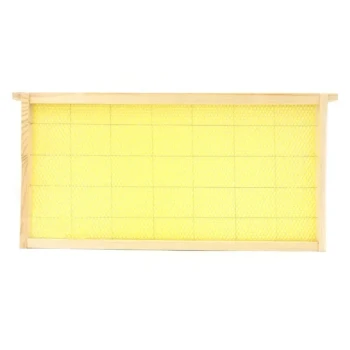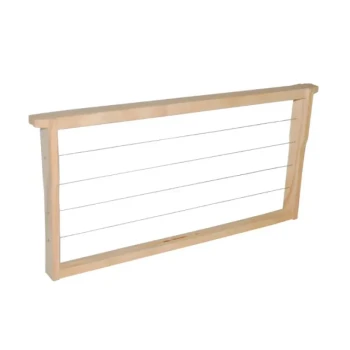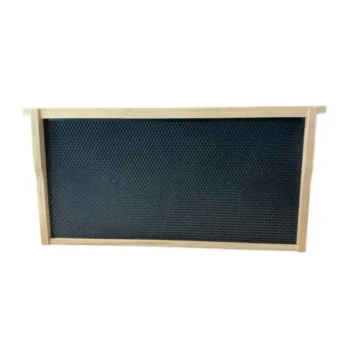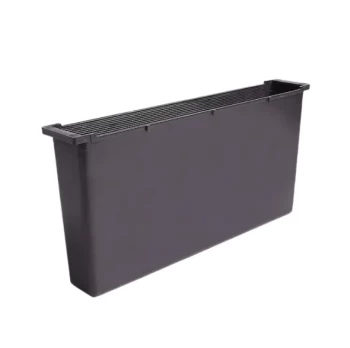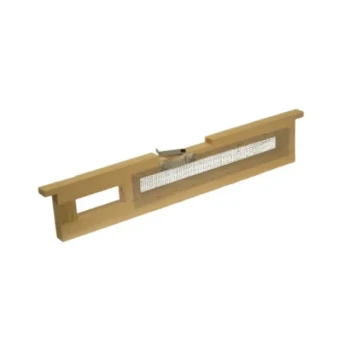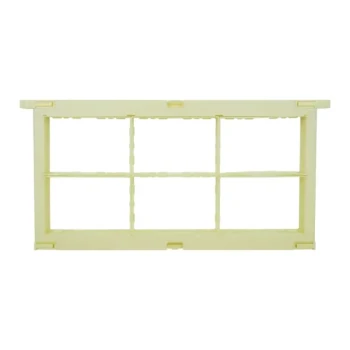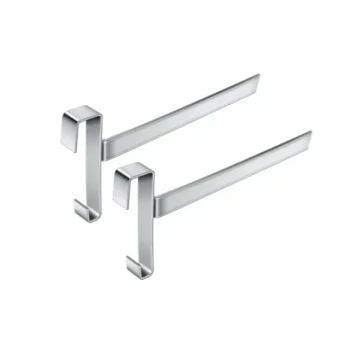In beekeeping, many types of used frames can be cleaned and returned to service. Frames with old, dark comb, comb clogged with dried pollen, or those with physical damage from wax moths or poor construction are all excellent candidates for refurbishment. Reusing this equipment is a common practice that saves both time and money.
The ability to reuse frames is a significant advantage in apiary management, but this decision must be governed by one unwavering principle: colony health. The critical skill is not just knowing how to clean a frame, but knowing when a frame is unsafe and must be destroyed.
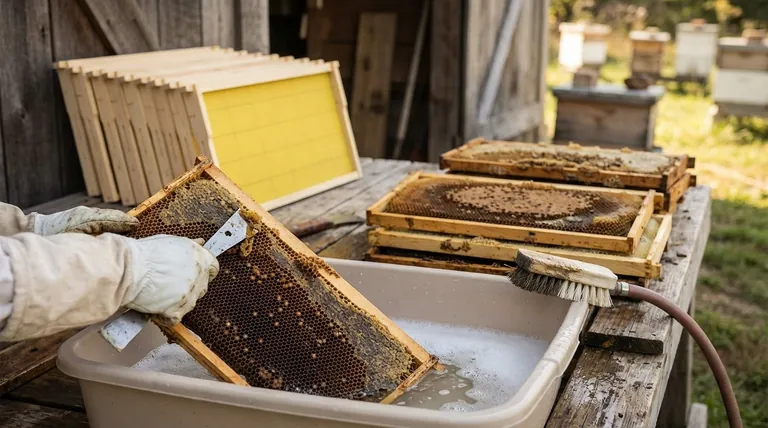
Identifying Salvageable Frames
Before you begin cleaning, the first step is a careful inspection. Most frames you encounter will be salvageable and fall into a few common categories.
Old, Dark Comb
As brood is raised cycle after cycle, the wax comb will progressively darken. This is a natural process caused by an accumulation of pupal cocoons and propolis.
This dark comb is not inherently harmful and can be scraped down to the foundation and reused. The bees will readily rebuild upon the existing cell structure.
Pollen-Clogged or Warped Comb
Frames can become "pollen-bound" when cells are filled with old, hardened pollen that the bees can no longer use.
Similarly, you will find frames with warped comb, lumpy patches, or large areas of drone comb. These are structural issues, not biological threats, and can be fixed by scraping the comb away.
Physical Damage
Mice or wax moths can cause significant damage to stored comb, chewing through the wax and leaving behind webbing and debris.
As long as the wooden frame and plastic foundation are intact, this damage is purely superficial. The debris and damaged wax can be completely removed, and the frame can be cleaned for reuse.
The Critical Exceptions: When to Destroy Frames
While most frames are reusable, some pose an unacceptable risk to your bees. Reusing a contaminated frame can spread pathogens throughout your apiary, with devastating consequences. When in doubt, throw it out.
The Specter of American Foulbrood (AFB)
If a colony has been lost to American Foulbrood (AFB), the frames and all associated equipment must be destroyed, typically by burning.
AFB spores are exceptionally resilient and can remain viable for decades, easily contaminating a healthy colony. Signs include a foul odor, sunken and perforated cappings, and a "ropy" or stringy test when a toothpick is inserted into a cell. Do not attempt to salvage these frames.
Other Brood Diseases
Diseases like Chalkbrood or Sacbrood are less persistent than AFB, but heavily infected frames should still be discarded. While some beekeepers might risk reusing frames with minor infections after a thorough cleaning, the safest practice is to cull them from your operation.
Suspected Chemical Contamination
Beeswax acts like a sponge, absorbing pesticides and other chemicals from the environment over time. If a colony dies unexpectedly with no clear cause, or if you suspect it was exposed to a chemical spray, it is safest to discard the comb and foundation.
The Cleaning and Refurbishment Process
Once you have identified a frame as safe to reuse, the process is straightforward. Your goal is to remove all old wax and debris, giving the bees a clean slate.
Step 1: Scrape Away the Old Comb
Using a standard hive tool or a putty knife, scrape all the old wax, propolis, and debris from the frame and foundation. Your goal is to get back down to the plastic foundation base.
Step 2: Scrub with Hot Water
After scraping, scrub the frames vigorously in a tub of hot, soapy water. The heat will help melt away any residual wax that you missed. Use a stiff brush to clean the frame and the individual cell patterns in the foundation.
Step 3: Rinse and Air Dry Correctly
Rinse the frames thoroughly with clean water to remove any soap residue.
Allow the frames to air dry completely. Crucially, keep them out of direct sunlight, as the heat from the sun can easily warp the plastic foundation, rendering the frame useless.
Making the Right Choice for Your Apiary
Your decision to reuse a frame should always align with your primary goal for hive management.
- If your primary focus is cost savings: Reusing frames with old but healthy comb is an excellent way to reduce equipment expenses and get swarms or new packages started quickly.
- If your primary focus is biosecurity: Be ruthless in discarding any frame with the slightest sign of persistent disease, especially American Foulbrood.
- If your primary focus is hive productivity: Regularly rotate out old, dark frames and replace them with fresh foundation to encourage vigorous brood rearing and clean honey storage.
By approaching frame management with both pragmatism and caution, you build a more resilient and sustainable apiary.
Summary Table:
| Frame Condition | Reusable? | Action Required |
|---|---|---|
| Old, Dark Comb | Yes | Scrape down to foundation |
| Pollen-Clogged Comb | Yes | Scrape away old wax |
| Physical Damage (Wax Moths/Mice) | Yes | Remove debris, clean thoroughly |
| American Foulbrood (AFB) | No - Destroy | Must be burned to prevent spore spread |
| Other Brood Diseases | No - Discard | Safest practice is to cull |
| Suspected Chemical Contamination | No - Discard | Beeswax absorbs pesticides |
Equip Your Apiary for Success with HONESTBEE
Managing your equipment effectively is key to a healthy, productive apiary. At HONESTBEE, we supply commercial apiaries and beekeeping equipment distributors with the durable, high-quality supplies needed for efficient operations—from robust frames and foundations to essential hive tools.
Let us help you build a more resilient and sustainable beekeeping business. Contact our wholesale team today to discuss your equipment needs and volume pricing.
Visual Guide
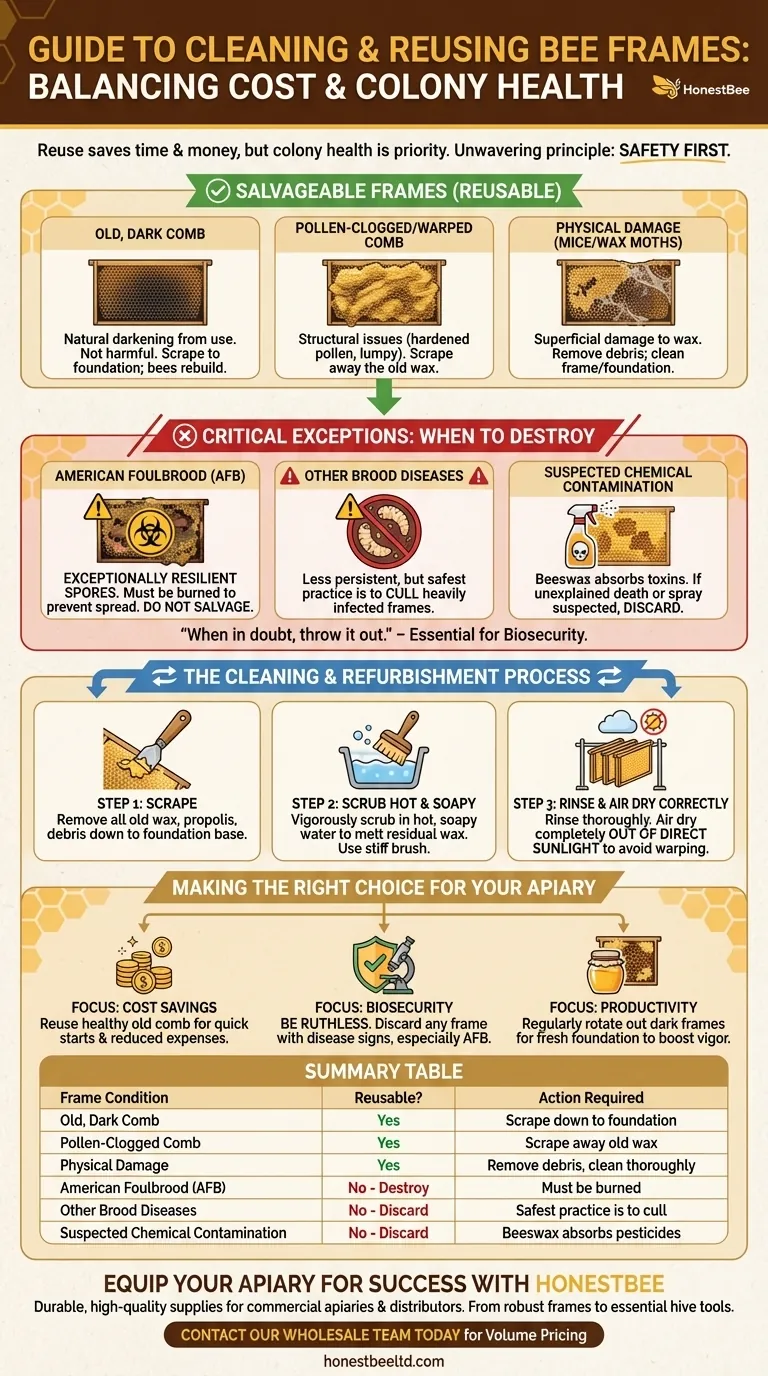
Related Products
- Assembled Wooden Bee Frames with Beeswax Foundation Ready to Use by HONESTBEE
- HONESTBEE Wired and Assembled Wooden Bee Frames Foundation for a Thriving Hive
- Assembled Wooden Bee Frames with Plastic Foundation for Durability and Convenience by HONESTBEE
- Plastic Bee Frame Beekeeping Hive Frames for Wholesale
- Heart-Shaped Comb Honey Frame and Honeycomb Cassette
People Also Ask
- Can old bee frames be reused? Weighing the Risks vs. Rewards for Your Hive
- When should I throw away my bee frame? A Guide to Hive Health & Frame Rotation
- What are some tips for setting up hive frames? Build a Strong Foundation for Your Hive
- How many frames fit in a 10 frame hive? A Guide to Maximizing Your Hive's Potential
- Can I reuse old frames? A practical guide to saving money and reducing waste
